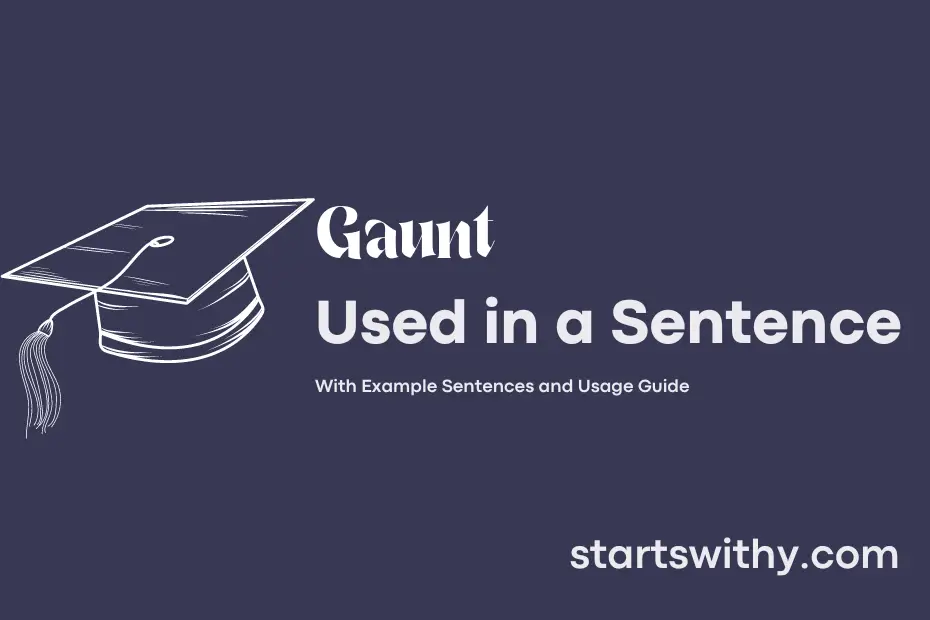Have you ever looked at someone who appeared unusually thin or drawn, as if they hadn’t eaten for days? This is what “gaunt” describes – a skeletal, hollow appearance often associated with malnutrition or illness.
This word is used to paint a vivid picture of extreme thinness or emaciation, conveying a sense of depletion or suffering. It can be applied to both people and animals, describing a sharp, stark appearance that suggests a lack of health or vitality.
7 Examples Of Gaunt Used In a Sentence For Kids
- The gaunt scarecrow stood in the field.
- The old man had a gaunt face with deep wrinkles.
- The haunted house had gaunt windows and creaky doors.
- The stray cat looked gaunt and hungry.
- The skeleton had gaunt arms and legs.
- The ghost had a gaunt appearance with sunken eyes.
- The witch had a gaunt figure with long, bony fingers.
14 Sentences with Gaunt Examples
- Gaunt from staying up all night studying for exams, she struggled to focus in class the next day.
- After weeks of surviving on instant noodles, he began to look gaunt from lack of proper nutrition.
- She felt gaunt after pulling an all-nighter to finish a group project before the deadline.
- Worrying about job prospects post-graduation left him looking gaunt as stress took its toll on his appearance.
- The intense heat and constant workload made many students appear gaunt by the end of the semester.
- Despite her gaunt appearance, she pushed through the fatigue and attended all her lectures.
- His gaunt features were evidence of the challenging internship he had taken on during the summer break.
- Juggling multiple responsibilities left her looking gaunt but she remained determined to excel in all areas of her life.
- Lack of sleep and poor eating habits resulted in many students looking gaunt towards the end of the academic year.
- The pressure of upcoming exams caused many students to become gaunt as they sacrificed rest for study time.
- She barely had time to eat or sleep, causing her to become gaunt as the semester progressed.
- Spending countless nights in the library made him appear gaunt as the stress of assignments and tests piled up.
- Students who took on part-time jobs often appeared gaunt due to the struggle of balancing work and academics.
- Some students seemed gaunt as they tried to cope with the demands of campus life and extracurricular activities.
How To Use Gaunt in Sentences?
To use “Gaunt” in a sentence, remember that this word typically means thin, bony, or lean.
Here is an example sentence:
– “After being stranded on the desert island for weeks, the castaway looked gaunt and malnourished.”
When constructing a sentence with the word Gaunt, consider using it to describe someone’s physical appearance. You can use it to convey a sense of thinness or emaciation.
Remember, “Gaunt” is an adjective that is used to describe a person’s appearance, so make sure to pair it with a noun to complete the sentence.
Here are a few more examples you can use:
– “The gaunt figure in the painting seemed to evoke a sense of melancholy.”
– “Due to the illness, she appeared gaunt and weak.”
Practice incorporating Gaunt into your vocabulary to become more comfortable using it in your writing and conversations. Remember to pay attention to the context in which this word is used to ensure it fits appropriately.
Conclusion
In conclusion, the word “gaunt” is often used to describe someone who appears thin, drawn, and haggard due to illness, malnutrition, or weariness. It is frequently used in literature to create a vivid image of a character’s physical appearance, emphasizing their suffering or hardship. For example, sentences like “The prisoner emerged from the dark cell, his gaunt face and sunken eyes revealing the harsh conditions he had endured” paint a stark picture of deprivation and struggle.
Overall, the word “gaunt” conveys a sense of physical and emotional distress, evoking feelings of sympathy in the reader by highlighting the hardships faced by the character. Its usage in sentences adds depth to descriptions and characterization, enhancing the reader’s understanding and emotional connection with the story.



